Description
The 109-500 is a self-contained, modular monopropellant Starthilfe (take-off assist) engine in a pod, able to produce 500 kg (1,100 lb) thrust for thirty seconds. After the fuel was expended, the pod was jettisoned and it returned to earth by parachute, [1] with the parachute packed externally, onto the blunt forward end of the pod.
The T-Stoff monopropellant, stored in the large spherical tank within the Starthilfe module's forward end, needed to react with a catalyst to provide the boosting thrust for an aircraft on takeoff - this Z-Stoff sodium or calcium-based, alkaline permanganate-compound (in an aqueous solution) catalyst was provided in a small tank above the reaction chamber just forward of the exhaust nozzle, with compressed air from a network of five pressure tanks driving the monopropellant and catalyst together through the reaction chamber, which featured an internal, fixed helical "swirl baffle" to lengthen the period of time the monopropellant and catalyst were in contact for a more complete catalytic reaction within it, before the reacted T-Stoff exhaust exited the nozzle. [2]
It entered service in 1942, and some 6,000 were built, by Heinkel. [1] It was "used extensively on a wide range of aircraft", especially the potentially underpowered (when heavily laden with external ordnance) Jumo 004-engined Arado Ar 234B, [1] with two of the units uniquely displayed as mounted operationally on the NASM's sole surviving, restored Ar 234B.

The Messerschmitt Me 163 Komet is a German interceptor aircraft designed for point-defence that is the only rocket-powered fighter aircraft ever to have been operational and the first piloted aircraft of any type to exceed 1000 km/h (621 mph) in level flight. Designed by Alexander Lippisch, its performance and aspects of its design were unprecedented. German test pilot Heini Dittmar in early July 1944 reached 1,130 km/h (700 mph), an unofficial flight airspeed record unmatched by turbojet-powered aircraft for almost a decade.

JATO, is a type of assisted take-off for helping overloaded aircraft into the air by providing additional thrust in the form of small rockets. The term JATO is used interchangeably with the term RATO, for rocket-assisted take-off.
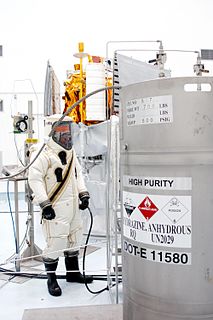
A hypergolic propellant combination used in a rocket engine is one whose components spontaneously ignite when they come into contact with each other.

The Enzian was a German WWII surface-to-air anti-aircraft missile that was the first to use a radio controlled guidance system. During the missile's development in the late stages of the war it was plagued by organisational problems and was cancelled before becoming operational.

The Arado Ar 234 Blitz was the world's first operational jet-powered bomber, built by the German Arado company in the closing stages of World War II.
T-Stoff ("substance T") was a stabilised high test peroxide used in Germany during World War II. T-Stoff was specified to contain 80% (occasionally 85%) hydrogen peroxide (H2O2), remainder water, with traces (<0.1%) of stabilisers. Stabilisers used included 0.0025% phosphoric acid, a mixture of phosphoric acid, sodium phosphate and 8-oxyquinoline, and sodium stannate.
Hellmuth Walter was a German engineer who pioneered research into rocket engines and gas turbines. His most noteworthy contributions were rocket motors for the Messerschmitt Me 163 and Bachem Ba 349 interceptor aircraft, so-called Starthilfe jettisonable rocket propulsion units used for a variety of Luftwaffe aircraft during World War II, and a revolutionary new propulsion system for submarines known as air-independent propulsion (AIP).

The Messerschmitt Me 263 Scholle (plaice) was a rocket-powered fighter aircraft developed from the Me 163 Komet towards the end of World War II. Three prototypes were built but never flown under their own power as the rapidly deteriorating military situation in Germany prevented the completion of the test program.

The Messerschmitt Me 321 Gigant was a large German cargo glider developed and used during World War II. Intended to support large scale invasions, the Me 321 saw very limited use due to the low availability of suitable tug aircraft, high vulnerability whilst in flight and the difficult ground handling, both at base and at destination landing sites. The Me 321 was developed, in stages, into the six-engined Messerschmitt Me 323 Gigant, which removed some of the problems with ground handling, but vulnerability to ground fire and aerial attack remained a constant problem during operations of all variants.
Z-Stoff was a name for calcium permanganate or sodium permanganate mixed in water. It was normally used as a catalyst for T-Stoff in military rocket programs by Nazi Germany during World War II.
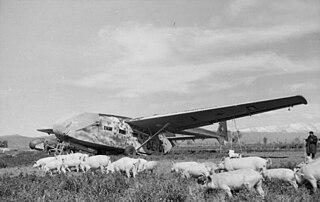
The Gotha Go 242 was a transport glider used by the Luftwaffe during World War II. It was an upgrade over the DFS 230 in both cargo/troop capacity and flight characteristics. Though it saw limited action, it appeared in multiple variants.
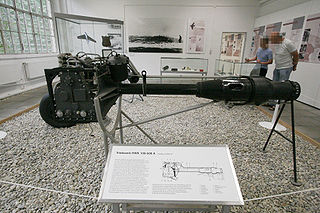
The Walter HWK 109-509 was a German liquid-fuel bipropellant rocket engine that powered the Messerschmitt Me 163 Komet and Bachem Ba 349 aircraft. It was produced by Hellmuth Walter Kommanditgesellschaft (HWK) commencing in 1943, with license production by the Heinkel firm's facilities in Jenbach, Austria.
Hellmuth Walter Kommanditgesellschaft (HWK), Helmuth Walter Werke (HWM), or commonly known as the Walter-Werke, was a German company founded by Professor Hellmuth Walter to pursue his interest in engines using hydrogen peroxide as a fuel.

The Arado E.381 was a proposed parasite fighter aircraft. Conceived by Arado Flugzeugwerke in December 1944 for Germany's Luftwaffe during World War II, the E.381 was to have been carried aloft by and launched from an Arado Ar 234 "mother" aircraft. It would then have activated its rocket engine, which would have propelled it to attack Allied bombers. Development was cancelled due to lack of funds and official support.
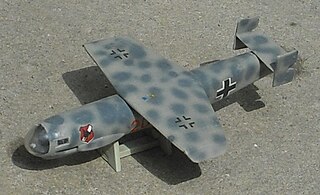
The Heinkel P.1077 was a single seat interceptor design developed for the Luftwaffe by Heinkel under the Emergency Fighter Program during the last year of the Third Reich. This rocket-powered project was originally known as He P.1068, but that name would later be used for a Heinkel design project for a turbojet-powered medium bomber.
The BMW 109-718 was a liquid-fuelled rocket engine developed by BMW at their Bruckmühl facility, in Germany during the Second World War.
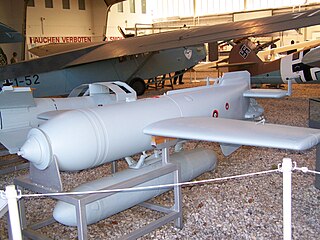
The HWK 109-507 was a liquid-propellant rocket engine developed by Germany during World War II. It was used to propel the Hs 293 anti-ship guided missile.
This page is based on this
Wikipedia article Text is available under the
CC BY-SA 4.0 license; additional terms may apply.
Images, videos and audio are available under their respective licenses.












